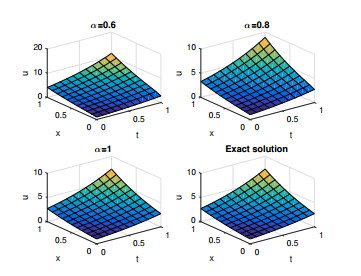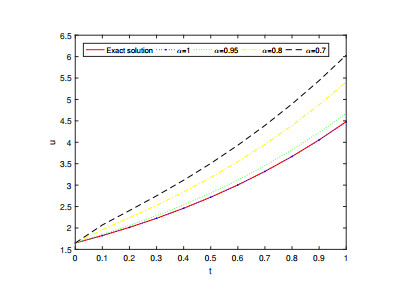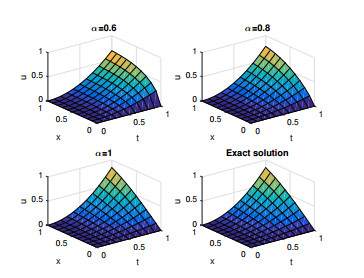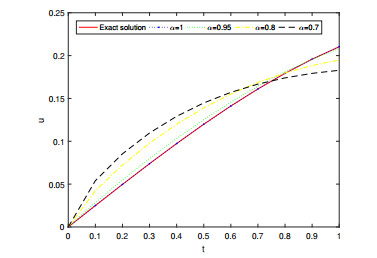1.
Introduction
Fractional calculus is a branch of mathematical analysis, which studies the generalization of integrals and derivatives of integer order to arbitrary order, that can be real or complex. In recent years, many scientists and researchers have been interested in the topic of fractional calculus because of its several applications in many fields, such as physics, chemistry, engineering, and so on. See for example [9,10,11,19,23,24,25].
Theory and applications of nonlinear fractional partial differential equations (NFPDEs) play an important role in the various fields of engineering and science, including fluid flow, diffusion, viscoelasticity, quantum mechanics, electromagnetic, electrochemistry, biological population models and other applications. The exact solutions of NFPDEs are sometimes too complicated to be attained by conventional techniques due to the computational complexities of nonlinear parts involving them. Therefore, to search of solutions for NFPDEs there are variety of numerical and analytical methods found in literature, among them: Adomian decomposition method (ADM) [22] variational iteration method (VIM) [6], new iterative method (NIM) [12], reduced differential transform method (RDTM) [2], homotopy analysis method (HAM) [3], homotopy perturbation method (HPM) [8]. The residual power series method (RPSM), that was first proposed by Omar Abu Arqub [1], is implemented to obtaine analytic approximate solutions of fractional partial differential equations and convergence of RPSM for these equations is considered [5,7,17,21].
The main aim of this paper is to apply the fractional residual power series method (FRPSM) to find approximate analytical solutions of nonlinear time-fractional wave-like equations with variable coefficients in the form
with the initial conditions
where D2αt=DαtDαt is the Caputo time-fractional derivative operator of order 2α, 12<α≤1, u={u(X,t),X=(x1,x2,...,xN)∈RN,t≥0,N∈N∗}, F1ij,G1i i,j∈{1,2,...,N} are nonlinear functions of X,t and u, F2ij,G2i i,j∈{1,2,...,N} are nonlinear functions of derivatives of u with respect to xi and xj i,j∈{1,2,...,N}, respectively. Also H,S are nonlinear functions and k,m,p are integers. When α=1, the equation (1.1) reduces to the classical wave-like equations with variable coefficients.
Recently, we have used many numerical techniques to solve this kind of equations, where the Caputo time-fractional derivative operator is Dαt,1<α≤2. Note that, the solution of Eqs. (1.1)-(1.2) obtained by the FRPSM is quite different from the solutions found in [12,13,14,15].
The rest of the paper is structured as follows: In Section 2, we present basic definitions and properties of fractional calculus theory and fractional power series. In Section 3, we introduce our results of fractional residual power series method (FRPSM) for the nonlinear time-fractional wave-like equations (1.1) with the initial conditions (1.2). In Section 4, we propose three numerical examples in order to show the validity and effectiveness of this approach. In Section 5, we discuss our obtained results represented by figures and table. Finally, conclusions are drawn in the last section.
2.
Basic definitions of fractional calculus theory
In this section, we give the necessary notations and basic definitions and properties of fractional calculus theory, which are used further in this paper. For more details, see [16,18,20].
Definition 2.1. A real function u(X,t),X∈RN,N∈N∗,t∈R+, is considered to be in the space Cμ(RN×R+), μ∈ R, if there exists a real number p>μ, so that u(X,t)=tpv(X,t), where v ∈C(RN×R+), and it is said to be in the space Cnμ if u(n)∈Cμ(RN×R+),n∈N.
Definition 2.2. The Riemann-Liouville fractional integral operator of order α>0 of u∈Cμ(RN×R+),μ≥−1, is defined as follows
Definition 2.3. The Caputo time-fractional derivative operator of order α>0 of u∈Cn−1(RN×R+),n∈N, is defined as follows
The following are the basic properties of the Caputo time-fractional derivative operator which we will need here.
Let n−1<α≤n and β≥−1. Then
(1)
(2)
For the Riemann-Liouville fractional integral and Caputo time-fractional derivative, we have the following relation
Now, we introduce some definitions and theorems related to the fractional power series (FPS) which are used in this paper. For more details, see [4].
Definition 2.4. A power series of the form
where m−1<α≤m and t≥t0is called the multiple fractional power series (MFPS) about t0, where t is a variable and cn(X) are constants called the coefficients of the series.
Theorem 2.1. Suppose that u(X,t) has a MFPS representation at t=t0 of the form
and R is the radius of convergence of the MFPS.
If u∈C(RN×[t0,t0+R)) and Dnαtu∈C(RN×(t0,t0+R)) for n=0,1,2,..., then the coefficients Cn(X) will take the form of
where Dnαt=Dαt.Dαt.....Dαt (n-times).
3.
FRPSM for time-fractional wave-like equations
Theorem 3.1. Consider the nonlinear time-fractional wave-like equations (1.1) with the initial conditions (1.2). Then, the solution of Eqs. (1.1)-(1.2) is given in the form of infinite series which converges rapidly to the exact solution as follows
where fn(X) are the coefficients of the series have been constructed by FRPSM and R is the radius of convergence.
Proof. We consider the following nonlinear time-fractional wave-like equations (1.1) with the initial conditions (1.2).
First we define
Eq. (1.1) is written in the form
The FRPSM assumes the solution for Eq. (3.1) as a multiple fractional power series about the initial point t=0, as follows
where R is the radius of convergence of the MFPS.
In the next step, the kth truncated series of u(X,t) that is uk(X,t) can be written as
Since the initial conditions in Eq. (1.2). Then, the approximate solution to (3.1) can be written in the form of
where f0(X)+f1(X)tαΓ(α+1) is considered to be the 1st FRPS approximate solution of u(X,t).
Then uk(X,t) could be reformulated as
Now, we define the residual function as
and the kth truncated residual function as
It is clear that Res(X,t)=0 and limk⟶∞Resk(X,t)=Res(X,t) for each X∈RN and t≥0. In fact this lead to D(n−2)αtRes(X,t)=0 for n=2,3,4,...,k because the fractional derivative of a constant is zero in the Caputo sense. Also, the fractional derivative D(n−2)αt of Res(X,t) and Resk(X,t) are matching at t=0 for each n=2,3,4,...,k, that is,
To clarify the FRPS technique, we substitute the kth truncated series of u(X,t) into Eq. (3.6), find the fractional derivative formula D(n−2)αt of Resk(X,t) and then, we solve the obtained algebraic (3.7), to get the required coefficients fn(X),n=2,3,4,...in Eq. (3.4). Thus the uk(X,t) approximate solutions can be obtained respectively.
4.
Numerical examples
In this section, we describe the method explained in the Section 3. Three numerical examples of nonlinear time-fractional wave-like equations with variable coefficients are considered to validate the capability, reliability and efficiency of FRPSM.
Example 4.1. Consider the 2-dimensional nonlinear time-fractional wave-like equation with variable coefficients
with the initial conditions
where D2αt is the Caputo fractional derivative operator of order 2α, u is a function of x,y,t∈R×R×R+.
For α=1, the exact solution of Eqs. (4.1)-(4.2) is given by [14]
According to FRPSM described in Section 3, by applying on the Eqs. (4.1)-(4.2), we have
First, the 1st FRPS approximate solution of u(x,y,t) is
Secondly, construct the kth truncated series and kth residual function of Eqs. (4.1)-(4.2) as follow
By (3.7), we have
Taking k=2 in (4.6), we obtain
Then, the 2nd truncated approximate solution will be
In a similar way, taking k=3,4,5 in (4.6), we have
Then the 5th order truncated approximate solution of Eqs. (4.1)-(4.2) can be obtained as follows
Following the same step, then the solution of Eqs. (4.1)-(4.2) can be expressed by
When α=1, the exact solution is
Remark 4.1. Comparing our obtained result (4.7) with the results in [12,13,14,15], it can be seen that the result is new.
Example 4.2. Consider the following nonlinear time-fractional wave-like equation with variable coefficients
with the initial conditions
where D2αtis the Caputo fractional derivative operator of order 2α, and u is a function of x,t∈]0,1[×R+.
For α=1, the exact solution of Eqs. (4.8)-(4.9) is given by [14]
According to FRPSM described in Section 3, by applying on the Eqs. (4.8)-(4.9), we have
First, the 1st FRPS approximate solution of u(x,t) is
Secondly, construct the kth truncated series and kth residual function of Eqs. (4.8)-(4.9) as follow
By (3.7), we have
Taking k=2 in (4.13), we obtain
Then the 2nd truncated approximate solution will be
In a similar way, taking k=3,4,5 in (4.13), we have
Then the 5th order truncated approximate solution of Eqs. (4.8)-(4.9) can be obtained as follows:
Following the same step, then the solution of Eqs. (4.8)-(4.9) can be expressed by
When α=1, the exact solution is
Remark 4.2. Comparing our obtained result (4.14) with the results in [12,13,14,15], it can be seen that the result is new.
Example 4.3 Consider the following one dimensional nonlinear time-fractional wave-like equation with variable coefficients
with the initial conditions
where D2αtis the Caputo fractional derivative operator oforder 2α, and u is a function of x,t∈]0,1[×R+.
For α=1, the exact solution of Eqs. (4.15)-(4.16) is given by [14]
According to FRPSM described in Section 3, by applying on the Eqs. (4.15)-(4.16), we have
First, the 1st FRPS approximate solution of u(x,t) is
Secondly, construct the kth truncated series and kth residual function of Eqs. (4.15)-(4.16) as follow
By (3.7), we have
Taking k=2 in (4.18), we obtain
Then the 2nd truncated approximate solution will be
In a similar way, taking k=3,4,5 in (4.20), we have
Then the 5th order truncated approximate solution of Eqs. (4.15)-(4.16) can be obtained as follows:
Following the same step, then the solution of Eqs. (4.15)-(4.16) can be expressed by
When α=1, the exact solution is
Remark 4.3. Comparing our obtained result (4.21) with the results in [12,13,14,15], it can be seen that the result is new.
5.
Numerical results and discussion
In this section, we discuss and evaluate the numerical results of the approximate solutions for Examples 4.1, 4.2 and 4.3 respectively. Figures 1, 3 and 5 represents the surface graph of the 5th FRPSM approximate solution at α=0.6,0.8,1 and the exact solution. Figures 2, 4 and 6 represents the behavior of the 5th FRPSM approximate solution at α=0.7,0.8,0.95,1 and the exact solution. These figures afirm that when the order of the fractional derivative α approaches 1, the approximate solutions obtained by FRPSM approach the exact solutions.
Tables 1–3 represents the numerical values of the 5th FRPSM approximate solution for different values of α and the exact solution. These tables clarifies the convergence of the approximate solutions to the exact solutions.
6.
Conclusion
In this paper, fractional residual power series method (FRPSM) is successfully applied to find approximate analytical solutions of time-fractional wave-like equations with variables coefficients. This method was tested on three numerical examples. Numerical results obtained confirm the easily, accurately and efficiency of the proposed method. The advantage of the FRPSM is that it reduces significantly the numerical computations to find approximate analytical solutions for this type of equations compared to current methods such as the perturbation technique, differential transform method (DTM) and Adomian decomposition method (ADM), thus, we can conclude that, the FRPSM is simple, effective, and practically method for solving many other nonlinear fractional partial differential equations.
Acknowledgments
The authors are thankful to a Professor Hamouche Zakia and to the anonymous referees for their careful checking of the details and for their valuable suggestions and comments which cause substantial improvements in the paper.
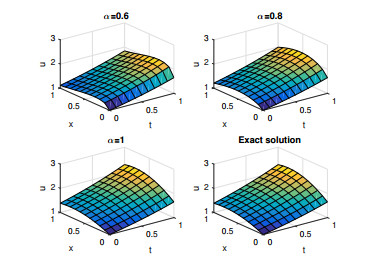









 DownLoad:
DownLoad:

